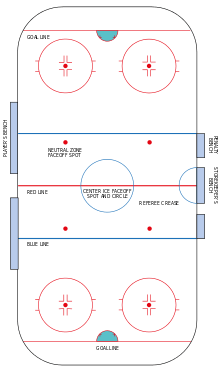Winger (ice hockey)
Winger, in the game of ice hockey, is a forward position of a player whose primary zone of play on the ice is along the outer playing area. They typically work by flanking the centre forward. Originally the name was given to forward players who went up and down the sides of the rink. Nowadays, there are different types of wingers in the game — out-and-out goal scorers, checkers who disrupt the opponents, and forwards who work along the boards and in the corners. They tend to be bigger than centreman and smaller than defenceman.
This position is commonly referred to by the side of the rink that the winger normally takes, i.e. "left wing" or "right wing."
Defensive zone play
The wingers' responsibilities in the defensive zone include the following:
- getting open for a pass from their teammates
- intercepting a pass to the opposing defenceman
- attacking the opposing defencemen when they have the puck
Wingers should typically not:
- play deep in their defensive zone
- help out their teammates along the boards
- cross to the other wing's side of the ice, especially in the defensive zone
Defensive play
Wingers should be playing high in the zone, and always be vigilant for a breakout pass or a chance to chip the puck past the blue line. When wingers receive a pass along the boards, they can exercise a number of options:
- Bank the puck off the boards or glass to get it out of the zone
- Redirect or softly pass the puck to a rushing forward
- Shoot the puck out to the centre line to another forward who can either set up an attack, or dump the puck into the offensive zone to summon a line change
- Carry the puck themselves into the offensive zone to attempt a breakaway or an odd man rush
Backchecking
Wingers are usually the last players to backcheck out of the offensive zone. On the backcheck, it is essential that they cover the last free opposing player rushing in. Once the puck is controlled by the opposing team in the defensive zone, however, wingers are responsible for covering the defenceman on their side of the ice.
Face-offs
Prior to the puck being dropped for a face-off, players other than those taking the face-off must not make any physical contact with players on the opposite team, nor enter the face-off circle (where marked). After the puck is dropped, it is essential for wingers to engage the opposing players to prevent them from obtaining possession of the puck.
Once a team has established control of the puck, wingers can set themselves up into an appropriate position.
Some wingers are also employed to handle faceoffs.[1]
See also
| Wikimedia Commons has media related to Ice hockey left wingers. |
| Wikimedia Commons has media related to Ice hockey right wingers. |
